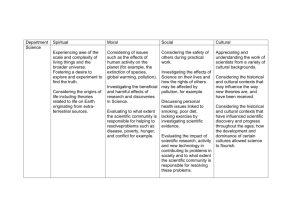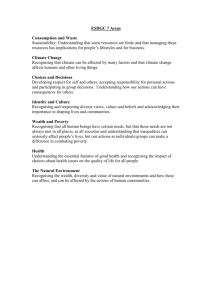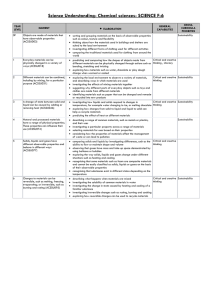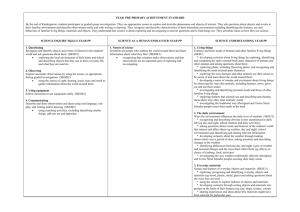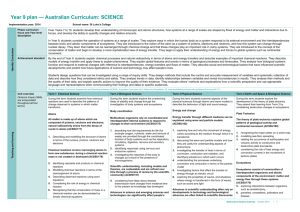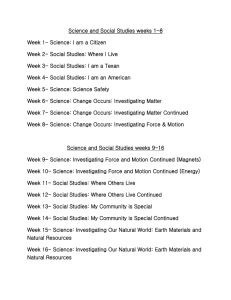Level 10 -Mapping Standards to Content Descriptions
advertisement
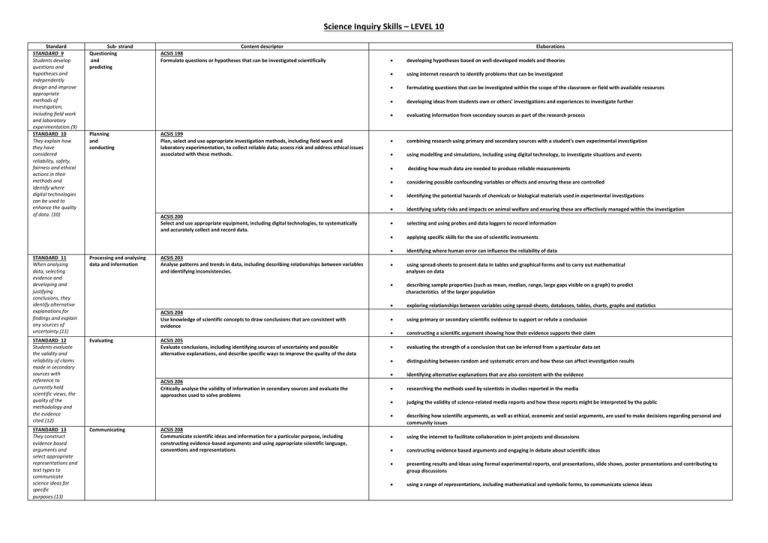
Science Inquiry Skills – LEVEL 10 Standard STANDARD 9 Students develop questions and hypotheses and independently design and improve appropriate methods of investigation, including field work and laboratory experimentation.(9) STANDARD 10 They explain how they have considered reliability, safety, fairness and ethical actions in their methods and identify where digital technologies can be used to enhance the quality of data. (10) Sub- strand Questioning and predicting Planning and conducting Content descriptor ACSIS 198 Formulate questions or hypotheses that can be investigated scientifically ACSIS 199 Plan, select and use appropriate investigation methods, including field work and laboratory experimentation, to collect reliable data; assess risk and address ethical issues associated with these methods. ACSIS 200 Select and use appropriate equipment, including digital technologies, to systematically and accurately collect and record data. STANDARD 11 When analysing data, selecting evidence and developing and justifying conclusions, they identify alternative explanations for findings and explain any sources of uncertainty.(11) Processing and analysing data and information STANDARD 12 Students evaluate the validity and reliability of claims made in secondary sources with reference to currently held scientific views, the quality of the methodology and the evidence cited.(12) Evaluating STANDARD 13 They construct evidence based arguments and select appropriate representations and text types to communicate science ideas for specific purposes.(13) Communicating ACSIS 203 Analyse patterns and trends in data, including describing relationships between variables and identifying inconsistencies. ACSIS 204 Use knowledge of scientific concepts to draw conclusions that are consistent with evidence ACSIS 205 Evaluate conclusions, including identifying sources of uncertainty and possible alternative explanations, and describe specific ways to improve the quality of the data ACSIS 206 Critically analyse the validity of information in secondary sources and evaluate the approaches used to solve problems ACSIS 208 Communicate scientific ideas and information for a particular purpose, including constructing evidence-based arguments and using appropriate scientific language, conventions and representations Elaborations developing hypotheses based on well-developed models and theories using internet research to identify problems that can be investigated formulating questions that can be investigated within the scope of the classroom or field with available resources developing ideas from students own or others' investigations and experiences to investigate further evaluating information from secondary sources as part of the research process combining research using primary and secondary sources with a student's own experimental investigation using modelling and simulations, including using digital technology, to investigate situations and events deciding how much data are needed to produce reliable measurements considering possible confounding variables or effects and ensuring these are controlled identifying the potential hazards of chemicals or biological materials used in experimental investigations identifying safety risks and impacts on animal welfare and ensuring these are effectively managed within the investigation selecting and using probes and data loggers to record information applying specific skills for the use of scientific instruments identifying where human error can influence the reliability of data using spread-sheets to present data in tables and graphical forms and to carry out mathematical analyses on data describing sample properties (such as mean, median, range, large gaps visible on a graph) to predict characteristics of the larger population exploring relationships between variables using spread-sheets, databases, tables, charts, graphs and statistics using primary or secondary scientific evidence to support or refute a conclusion constructing a scientific argument showing how their evidence supports their claim evaluating the strength of a conclusion that can be inferred from a particular data set distinguishing between random and systematic errors and how these can affect investigation results identifying alternative explanations that are also consistent with the evidence researching the methods used by scientists in studies reported in the media judging the validity of science-related media reports and how these reports might be interpreted by the public describing how scientific arguments, as well as ethical, economic and social arguments, are used to make decisions regarding personal and community issues using the internet to facilitate collaboration in joint projects and discussions constructing evidence based arguments and engaging in debate about scientific ideas presenting results and ideas using formal experimental reports, oral presentations, slide shows, poster presentations and contributing to group discussions using a range of representations, including mathematical and symbolic forms, to communicate science ideas Science as a Human Endeavour – LEVEL 10 Standard Sub- strand Nature and development of science STANDARD 8 Students analyse how the models and theories they use have developed over time and discuss the factors that prompted their review.(8) Content descriptor ACSHE 191 Scientific understanding, including models and theories, are contestable and are refined over time through a process of review by the scientific community ACSHE 192 Advances in scientific understanding often rely on developments in technology and technological advances are often linked to scientific discoveries Use and influence of science ACSHE 194 People can use scientific knowledge to evaluate whether they should accept claims, explanations or predictions ACSHE 195 Advances in science and emerging sciences and technologies can significantly affect people’s lives, including generating new career opportunities ACSHE 230 The values and needs of contemporary society can influence the focus of scientific research Elaborations considering the role of different sources of evidence including biochemical, anatomical and fossil evidence for evolution by natural selection investigating the development of the Watson and Crick double helix model for the structure of DNA investigating the history and impact of developments in genetic knowledge investigating the development of the periodic table and how this was dependent on experimental evidence at the time considering the role of science in identifying and explaining the causes of climate change recognising that Australian scientists such as Brian Schmidt and Penny Sackett are involved in the exploration and study of the universe recognising that the development of fast computers has made possible the analysis of DNA sequencing, radio astronomy signals and other data considering how computer modelling has improved knowledge and predictability of phenomena such as climate change and atmospheric pollution researching examples of major international scientific projects, for example the Large Hadron Collider and the International Space Station considering how information technology can be applied to different areas of science such as bioinformatics and the Square Kilometre Array describing how science is used in the media to explain a natural event or justify people’s actions using knowledge of science to test claims made in advertising considering the scientific knowledge used in discussions relating to climate change evaluating claims relating to environmental footprints predicting future applications of aspects of nanotechnology on people’s lives recognising that the study of the universe and the exploration of space involve teams of specialists from the different branches of science, engineering and technology considering how the computing requirements in many areas of modern science depend on people working in the area of information technology investigating the applications of gene technologies such as gene therapy and genetic engineering recognising that scientific developments in areas such as sustainable transport and low-emissions electrical generation require people working in a range of fields of science, engineering and technology investigating technologies associated with the reduction of carbon pollution, such as carbon capture considering innovative energy transfer devices, including those used in transport and communication investigating the use and control of CFCs based on scientific studies of atmospheric ozone recognising that financial backing from governments or commercial organisations is required for scientific developments and that this can determine what research is carried out considering the use of genetic testing for decisions such as genetic counselling, embryo selection, identification of carriers of genetic mutations and the use of this information for personal use or by organisation such as insurance companies or medical facilities Science understanding – LEVEL 10 Standard STANDARD 7 They explain the processes that underpin heredity and evolution.(7) Sub- strand Biological sciences Content descriptor ACSSU 184 The transmission of heritable characteristics from one generation to the next involves DNA and genes ACSSU 185 The theory of evolution by natural selection explains the diversity of living things and is supported by a range of scientific evidence STANDARD 1 Students analyse how the periodic table organises elements and use it to make predictions about the properties of elements. (1) Chemical sciences STANDARD 2 They explain how chemical reactions are used to produce particular products and how different factors influence the rate of reactions.(2) STANDARD 6 They evaluate the evidence for scientific theories that explain the origin of the universe and the diversity of life on Earth. (6) STANDARD 5 Students describe and analyse interactions and cycles within and between Earth’s spheres.(5) ACSSU 186 The atomic structure and properties of elements are used to organise them in the Periodic Table ACSSU 187 Different types of chemical reactions are used to produce a range of products and can occur at different rates Earth and space sciences ACSSU 188 The universe contains features including galaxies, stars and solar systems and the Big Bang theory can be used to explain the origin of the universe ACSSU 189 Global systems, including the carbon cycle, rely on interactions involving the biosphere, lithosphere, hydrosphere and atmosphere Elaboration describing the role of DNA as the blueprint for controlling the characteristics of organisms using models and diagrams to represent the relationship between DNA, genes and chromosomes recognising that genetic information passed on to offspring is from both parents by meiosis and fertilisation representing patterns of inheritance of a simple dominant/recessive characteristic through generations of a family predicting simple ratios of offspring genotypes and phenotypes in crosses involving dominant/recessive gene pairs or in genes that are sex-linked describing mutations as changes in DNA or chromosomes and outlining the factors that contribute to causing mutations outlining processes involved in natural selection including variation, isolation and selection describing biodiversity as a function of evolution investigating changes caused by natural selection in a particular population as a result of a specified selection pressure such as artificial selection in breeding for desired characteristics relating genetic characteristics to survival and reproductive rates evaluating and interpreting evidence for evolution, including the fossil record, chemical and anatomical similarities, and geographical distribution of species recognising that elements in the same group of the periodic table have similar properties describing the structure of atoms in terms of electron shells explaining how the electronic structure of an atom determines its position in the periodic table and its properties investigating the chemical activity of metals investigating how chemistry can be used to produce a range of useful substances such as fuels, metals and pharmaceuticals predicting the products of different types of simple chemical reactions using word or symbol equations to represent chemical reactions investigating the effect of a range of factors, such as temperature and catalysts, on the rate of chemical reactions identifying the evidence supporting the Big Bang theory, such as Edwin Hubble’s observations and the detection of microwave radiation recognising that the age of the universe can be derived using knowledge of the Big Bang theory describing how the evolution of the universe, including the formation of galaxies and stars, has continued since the Big Bang investigating how human activity affects global systems modelling a cycle, such as the water, carbon, nitrogen or phosphorus cycle within the biosphere explaining the causes and effects of the greenhouse effect investigating the effect of climate change on sea levels and biodiversity considering the long-term effects of loss of biodiversity STANDARD 3 They explain the concept of energy conservation and represent energy transfer and transformation within systems. (3) STANDARD 4 They apply relationships between force, mass and acceleration to predict changes in the motion of objects. (4) Physical sciences ACSSU 190 Energy conservation in a system can be explained by describing energy transfers and transformations ACSSU 229 The motion of objects can be described and predicted using the laws of physics investigating currently occurring changes to permafrost and sea ice and the impacts of these changes examining the factors that drive the deep ocean currents, their role in regulating global climate, and their effects on marine life recognising that the Law of Conservation of Energy explains that total energy is maintained in energy transfer and transformation recognising that in energy transfer and transformation, a variety of processes can occur, so that the usable energy is reduced and the system is not 100% efficient comparing energy changes in interactions such as car crashes, pendulums, lifting and dropping using models to describe how energy is transferred and transformed within systems gathering data to analyse everyday motions produced by forces, such as measurements of distance and time, speed, force, mass and acceleration recognising that a stationary object, or a moving object with constant motion, has balanced forces acting on it using Newton’s Second Law to predict how a force affects the movement of an object recognising and applying Newton’s Third Law to describe the effect of interactions between two objects
